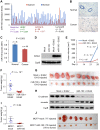miR-100 induces epithelial-mesenchymal transition but suppresses tumorigenesis, migration and invasion
- PMID: 24586203
- PMCID: PMC3937226
- DOI: 10.1371/journal.pgen.1004177
miR-100 induces epithelial-mesenchymal transition but suppresses tumorigenesis, migration and invasion
Abstract
Whether epithelial-mesenchymal transition (EMT) is always linked to increased tumorigenicity is controversial. Through microRNA (miRNA) expression profiling of mammary epithelial cells overexpressing Twist, Snail or ZEB1, we identified miR-100 as a novel EMT inducer. Surprisingly, miR-100 inhibits the tumorigenicity, motility and invasiveness of mammary tumor cells, and is commonly downregulated in human breast cancer due to hypermethylation of its host gene MIR100HG. The EMT-inducing and tumor-suppressing effects of miR-100 are mediated by distinct targets. While miR-100 downregulates E-cadherin by targeting SMARCA5, a regulator of CDH1 promoter methylation, this miRNA suppresses tumorigenesis, cell movement and invasion in vitro and in vivo through direct targeting of HOXA1, a gene that is both oncogenic and pro-invasive, leading to repression of multiple HOXA1 downstream targets involved in oncogenesis and invasiveness. These findings provide a proof-of-principle that EMT and tumorigenicity are not always associated and that certain EMT inducers can inhibit tumorigenesis, migration and invasion.
Conflict of interest statement
The authors have declared that no competing interests exist.
Figures







Similar articles
-
miR-448 inhibits the epithelial-mesenchymal transition in breast cancer cells by directly targeting the E-cadherin repressor ZEB1/2.Exp Biol Med (Maywood). 2018 Mar;243(5):473-480. doi: 10.1177/1535370218754848. Epub 2018 Jan 25. Exp Biol Med (Maywood). 2018. PMID: 29368542 Free PMC article.
-
MicroRNA-34a targets epithelial to mesenchymal transition-inducing transcription factors (EMT-TFs) and inhibits breast cancer cell migration and invasion.Oncotarget. 2017 Mar 28;8(13):21362-21379. doi: 10.18632/oncotarget.15214. Oncotarget. 2017. PMID: 28423483 Free PMC article.
-
The miR-200 family inhibits epithelial-mesenchymal transition and cancer cell migration by direct targeting of E-cadherin transcriptional repressors ZEB1 and ZEB2.J Biol Chem. 2008 May 30;283(22):14910-4. doi: 10.1074/jbc.C800074200. Epub 2008 Apr 14. J Biol Chem. 2008. PMID: 18411277 Free PMC article.
-
The E-Cadherin and N-Cadherin Switch in Epithelial-to-Mesenchymal Transition: Signaling, Therapeutic Implications, and Challenges.Cells. 2019 Sep 20;8(10):1118. doi: 10.3390/cells8101118. Cells. 2019. PMID: 31547193 Free PMC article. Review.
-
Melatonin and Its Role in the Epithelial-to-Mesenchymal Transition (EMT) in Cancer.Cancers (Basel). 2024 Feb 27;16(5):956. doi: 10.3390/cancers16050956. Cancers (Basel). 2024. PMID: 38473317 Free PMC article. Review.
Cited by
-
The role of miR-100 in regulating apoptosis of breast cancer cells.Sci Rep. 2015 Jul 1;5:11650. doi: 10.1038/srep11650. Sci Rep. 2015. PMID: 26130569 Free PMC article.
-
Integrating full spectrum of sequence features into predicting functional microRNA-mRNA interactions.Bioinformatics. 2015 Nov 1;31(21):3529-36. doi: 10.1093/bioinformatics/btv392. Epub 2015 Jun 30. Bioinformatics. 2015. PMID: 26130578 Free PMC article.
-
MicroRNA-Related Genetic Variants Associated with Survival of Head and Neck Squamous Cell Carcinoma.Cancer Epidemiol Biomarkers Prev. 2019 Jan;28(1):127-136. doi: 10.1158/1055-9965.EPI-18-0002. Epub 2018 Jun 7. Cancer Epidemiol Biomarkers Prev. 2019. PMID: 29880533 Free PMC article.
-
Epitelial-to-mesenchimal transition and invasion are upmodulated by tumor-expressed granzyme B and inhibited by docosahexaenoic acid in human colorectal cancer cells.J Exp Clin Cancer Res. 2016 Feb 2;35:24. doi: 10.1186/s13046-016-0302-6. J Exp Clin Cancer Res. 2016. PMID: 26830472 Free PMC article.
-
Semaphorin 3 C drives epithelial-to-mesenchymal transition, invasiveness, and stem-like characteristics in prostate cells.Sci Rep. 2017 Sep 13;7(1):11501. doi: 10.1038/s41598-017-11914-6. Sci Rep. 2017. PMID: 28904399 Free PMC article.
References
-
- Thiery JP (2002) Epithelial-mesenchymal transitions in tumour progression. Nat Rev Cancer 2: 442–454. - PubMed
-
- Yang J, Weinberg RA (2008) Epithelial-mesenchymal transition: at the crossroads of development and tumor metastasis. Dev Cell 14: 818–829. - PubMed
-
- Scheel C, Onder T, Karnoub A, Weinberg RA (2007) Adaptation versus selection: the origins of metastatic behavior. Cancer Res 67: 11476–11479 discussion 11479–11480. - PubMed
-
- Gregory PA, Bert AG, Paterson EL, Barry SC, Tsykin A, et al. (2008) The miR-200 family and miR-205 regulate epithelial to mesenchymal transition by targeting ZEB1 and SIP1. Nat Cell Biol 10: 593–601. - PubMed
Publication types
MeSH terms
Substances
Grants and funding
LinkOut - more resources
Full Text Sources
Other Literature Sources
Molecular Biology Databases
Research Materials
Miscellaneous

